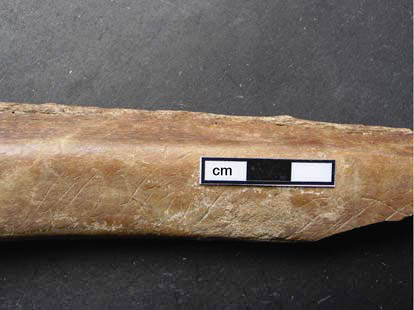More than ten thousands of bone fragments were recovered from the Lingjing site, Henan Province during 2005 and 2006. By taking statistical analyses of the skeletal elements of the two predominant species in this assemblage, aurochs (
Bos primigenius) and horse (
Equus caballus), scientists from the Institute of Vertebrate Paleontology and Paleoanthropology (IVPP), Chinese Academy of Sciences, and Henan Provincial Institute of Cultural Relics and Archaeology, found that hominids at this site have already practiced sophisticated hunting techniques and subsistence strategies and may be quite familiar with the ecological and anatomical characteristics and nutritional values of the large-sized prey animals and can accordingly take different processing and handling strategies at the hunting site, as reported in the journal of
Scince China Earth Sciences, 2012, 55 (2).
The Lingjing site is located in the west part of Lingjing town, about 15 km to the northwest of the Xuchang City, Henan Province and stands at an elevation point of 117 m. Initially discovered in the middle of the 20th century, this site was re-excavated by researchers from the Henan Provincial Institute of Cultural Relics and Archaeology during 2005 to 2006. Within an area of about 300 m
2, the Lingjing site yielded nearly 20 fragments of human fossils, 10 thousands of stone artifacts and more than 10000 pieces of animal fossils. Within the Chinese Paleolithic cultural system, it is of the transitional status between the Early and Later Paleolithic Age. Animal fossils in statistics are primarily from the stratum bearing the hominid fossils - the “Lower Cultural Layer”.
Researchers assessed the differential influences and weights of a variety of taphonomic agencies in the formation of the assemblage, and found hominid hunting and the subsequent disarticulation, slaughtering, and their transport of the bone elements of the prey species are the main factors accounting for the formation of the present assemblage.
After observing the distributional patterns of cut marks on the long bones of animals from the site, researchers found that most cut marks were on the midshaft portions of the bone (185 pieces, 98.45%), whereas only two pieces of distal epiphysis and one piece of proximal epiphysis (1.06% and 0.53%) were cut-marked. And of all the cut-marked long bones, 34% and 41% specimens belong to the upper and middle limbs of herbivores respectively, whereas only 25% belong to the lower limbs. This data suggests that hominids at the Lingjing site first accessed the animal resources prior to the carnivores and cut off the meat on the long bones.
Mortality patterns for two dominant species of the Lingjing site indicate that both animals have the mortality profiles of prime-adults dominated and accompanied by a small proportion of juvenile individuals, implying that hominids there already had relatively mature and systematical living strategies and social organizations in this period.
The distributions of the long bone circumferences and bone lengths could partially reflect the differential modifications of the hominids and carnivores on archaeofauna. The long bone circumferences of most specimens of the Lingjing assemblage is less than 25%, which is identical to that of hominid sites, but much different from that of the carnivore lairs. The lengths of 1300 pieces of long bones measured, are mostly distributed in the area of 3–6 or 6–9 cm, clearly displaying hominids’ influences on the archaeofauna at the Lingjing site.
There is a big difference between the skeletal element profiles of aurochs and horse in the Lingjing assemblage. There are relatively more fragments of horse’s skulls and mandibles, but its long bones are almost absent from the site. Perhaps, just as modern humans did, hominids always preferred to transport all the skeletal parts of the horses back to their base-camps whereas they dropped most of the bones of the aurochs in the killing sites. As compared to the artiodactyls, skeletal elements of the equids have relatively stronger muscle attachment points, and even after a more detailed field processing (such as defleshings, etc.) there will still be a large amount of nutritional components attached to the bone surfaces. If hominids dropped the bones in the field, it will inevitably have resulted in the loss of much nutrients. Furthermore, the marrow cavities within the long bones of equids are significantly smaller and its marrow content is mainly inside the spongy parts of the bones, which cannot be efficiently utilized by ancient humans.
The taphonomic study of the Lingjing site shows that this fauna is not a consequence of a large-scale hunting activity, instead it is just a final synthesis of several episodes of small-scale hunting events. For homonids with limited resources, perhaps the most sensible choice is to move those skeletal elements which still have much nutritional contents adhered, back to the base-camp, where they not only have enough time, but also have technology and capacity to extract nutrition thoroughly from those bones.
“The study of skeletal element profiles is an essential tool to reconstruct hominid behaviors, their social activities or the functions of archaeological sites”, said study lead author Dr. ZHANG Shuangquan of the IVPP, “This study initiatively identifies hominid’s differential treatment of the bones of aurochs and horse in the Paleolithic record of East Asia”.
This work was supported by the Knowledge Innovation Program of the Chinese Academy of Sciences, the Strategic Priority Research Program of the Chinese Academy of Sciences and the National Natural Science Foundation of China.

Fig.1 Cut marks on the rib of a large-sized herbivore from the Lingjing archaeological site, Xuchang City, Henan Province. (Image by ZHANG Shuangquan)
